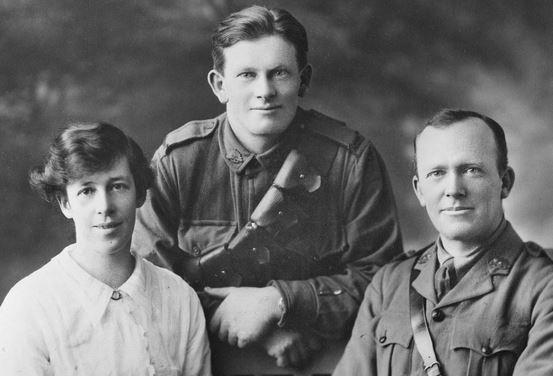After the war

Artist Frances Vida Lahey with two of her brothers, Noel and Romeo, during the war.
When the Lahey brothers went away to war, their 32-year-old sister Vida was determined to join them.
The eldest of 12 children, Frances Vida Lahey was working as an artist at her studio in Brisbane when the First World War broke out.
She had studied under prominent painters such as Frederick McCubbin at the National Gallery School in Melbourne, and had exhibited her work to great acclaim in 1912, but the outbreak of war in 1914 changed everything.
Her youngest brother, Jack, enlisted for active service in the wake of the Gallipoli landings and arrived on the Gallipoli peninsula in October 1915. He soon became dangerously ill with enteric fever, and was evacuated to Egypt before being sent back to Australia. Undeterred, he returned to active service before he was fully recovered and rejoined his battalion on the Western Front.
When two of Vida’s other brothers – Noel and Romeo – also volunteered, Vida abandoned her artistic pursuits and moved to London to provide a home base for her brothers and cousins serving in the Australian Imperial Force.
Soon after arriving she volunteered for the war effort, tracing aeroplane parts, working at the Anzac buffet, taking servicemen on convalescent leave on outings, and helping with the Red Cross Society.
When the guns finally fell silent on 11 November 1918, Vida watched on as joyous celebrations broke out on the streets of London and euphoric crowds gathered in Trafalgar Square, but her joy was tempered by the knowledge that one of her brothers would never come home.
During the war, Noel had requested a transfer to the 11th Field Company Australian Engineers to be his brother Romeo, and was wounded in action at Ploegsteert Wood in June 1917.
He was admitted to the 9th Australian Field Ambulance suffering from multiple gun-shot wounds. Romeo visited him, and he died the next day. He was just 25 years old, and was buried at Pont D’Achelles Military Cemetery, near Armentieres.
Several months later, Vida’s youngest brother Jack was shot in the arm, and evacuated to England. He was invalided home to Australia. Vida and Romeo remained in Europe and continued to serve for the rest of the war.

A studio portrait of Vida Lahey's brother Jack.
Romeo fought at Zonnebeke, Passchendaele, Villers-Bretonneux, and in the final advance to the heavily-fortified Hindenburg Line. He returned to Australia in May 1919, but Vida stayed in Europe, travelling to the Netherlands and France, and rekindling her passion for art.
She returned to Australia in 1920 and became a respected artist, but the conflicting scenes she witnessed at the end of the war never left her. Years later, she created the moving painting, Rejoicing and remembrance, Armistice Day, London, 1918.
The work, which features groups of women mourning and rejoicing at St Martin's in the Field in Trafalgar Square, is now part of the National Collection at the Australia War Memorial.
Assistant curator Dr Kerry Neale said Vida’s work was particularly moving.
“The consequences of war are immense, but what the Memorial does really well is tell the human side of conflict - the personal stories of those who served and the loved ones they left behind,” she said.

Vida Lahey's Rejoicing and remembrance, Armistice Day, London, 1918.
“The end of the First World War brought a mixture of relief and heartbreaking loss, and for many these feelings would remain for decades after the guns fell silent.
“The mass celebrations of war’s end, the tender moments of families reunited, and the struggle with grief and mourning are experiences that have always marked the end of warfare, but for a lot of people the war is just one part of their life. It may be a significant part of their life, but there is still so much more that comes after that is coloured and influenced by their experience.
“Even if that person doesn’t survive their war experience, it is their families that carry that burden and their story.
“It’s all about those ripple effects that go through the immediate family and down through the generations, and I feel that it is really important to acknowledge as well; what the consequences are for the individuals, for their families, and for their communities.
“Vida Lahey’s story really highlights the duality of emotion that people felt at the end of the war …
“You can really see her as someone who is conflicted in celebrating a victory while at the same time mourning the loss of a loved one and she encapsulates that in this artwork, Rejoicing and remembering, when you see the mourners going into the chapel at St Martins in the Fields as well seeing the revellers and those celebrating just outside in the street. You really get that sense of the conflicting emotion.
“Australia has been very fortunate – we have been on the side of victory – but it always comes at a very high price and Vida experienced that through the loss of one brother and the return of the other two.
“For Vida, it was victory at a cost, and that is what this … is really all about – the cost of conflict.”
Claire Hunter is a writer for the Australian War Memorial.
The Memorial is temporarily closed to the public, but the Memorial is still telling stories about the Australian experience of war. To learn more visit www.awm.gov.au/visit/museum-at-home
There will be a nationally televised Anzac Day commemorative service on 25 April 2020 which will be closed to the public. The ABC coverage will begin at 5.00 am with the service starting at 5.30 am. It will also be streamed live online.